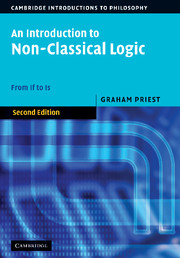Book contents
- Frontmatter
- Contents
- Preface to the First Edition
- Preface to the Second Edition
- Mathematical Prolegomenon
- Part I Propositional Logic
- 1 Classical Logic and the Material Conditional
- 2 Basic Modal Logic
- 3 Normal Modal Logics
- 4 Non-normal Modal Logics; Strict Conditionals
- 5 Conditional Logics
- 6 Intuitionist Logic
- 7 Many-valued Logics
- 8 First Degree Entailment
- 9 Logics with Gaps, Gluts and Worlds
- 10 Relevant Logics
- 11 Fuzzy Logics
- 11a Appendix: Many-valued Modal Logics
- Postscript: An Historical Perspective on Conditionals
- Part II Quantification and Identity
- Postscript: A Methodological Coda
- References
- Index of Names
- Index of Subjects
11a - Appendix: Many-valued Modal Logics
Published online by Cambridge University Press: 05 June 2012
- Frontmatter
- Contents
- Preface to the First Edition
- Preface to the Second Edition
- Mathematical Prolegomenon
- Part I Propositional Logic
- 1 Classical Logic and the Material Conditional
- 2 Basic Modal Logic
- 3 Normal Modal Logics
- 4 Non-normal Modal Logics; Strict Conditionals
- 5 Conditional Logics
- 6 Intuitionist Logic
- 7 Many-valued Logics
- 8 First Degree Entailment
- 9 Logics with Gaps, Gluts and Worlds
- 10 Relevant Logics
- 11 Fuzzy Logics
- 11a Appendix: Many-valued Modal Logics
- Postscript: An Historical Perspective on Conditionals
- Part II Quantification and Identity
- Postscript: A Methodological Coda
- References
- Index of Names
- Index of Subjects
Summary
Introduction
11a.1.1 In standard modal logics, the worlds are two-valued, in the following sense: there are two values (true and false) that a sentence may take at a world. Technically, however, there is no reason why this has to be the case: the worlds could be many-valued. This chapter looks at many-valued modal logics.
11a.1.2 We will start with the general structure of a many-valued modal logic. To illustrate the general structure, we will look briefly at modal logic based on Łukasiewicz continuum-valued logic.
11a.1.3 We will then look at one particular many-valued modal logic in more detail, modal First Degree Entailment (FDE), and its special cases, modal K3 and modal LP. In particular, tableau systems for these logics will be given.
11a.1.4 Modal many-valued logics engage with a number of philosophical issues. The final part of the chapter will illustrate by returning to the issue of future contingents.
General Structure
11a.2.1 As we observed in 7.2, semantically, a propositional many-valued logic is characterised by a structure 〈V, D, {fc : c ∈ C}〉, where V is the set of semantic values, D ⊇ V is the set of designated values, and for each connective, c, fc is the truth function it denotes. An interpretation, ν, assigns values in V to propositional parameters; the values of all formulas can then be computed using the fcs; and a valid inference is one that preserves designated values in every interpretation.
- Type
- Chapter
- Information
- An Introduction to Non-Classical LogicFrom If to Is, pp. 241 - 258Publisher: Cambridge University PressPrint publication year: 2008



